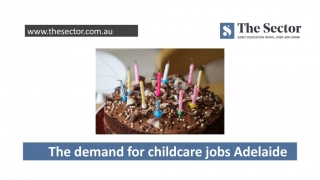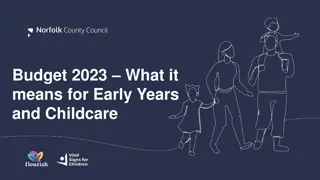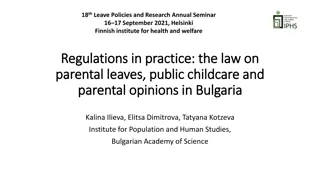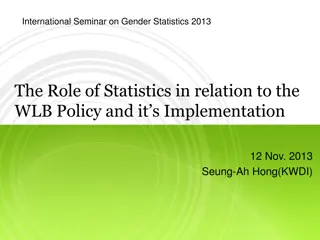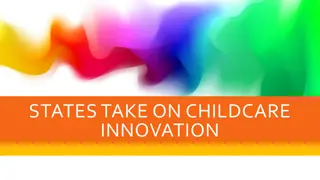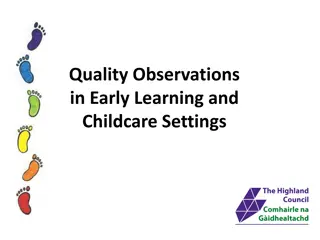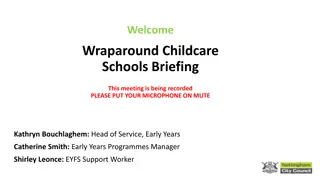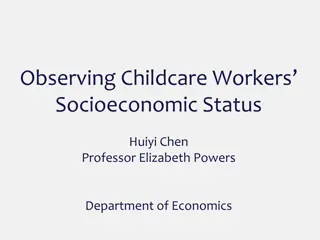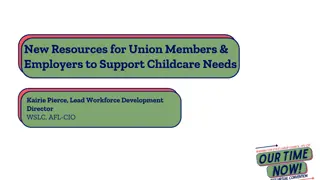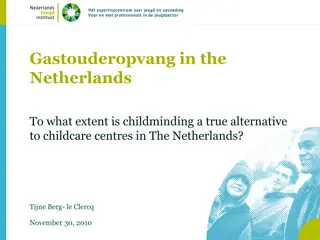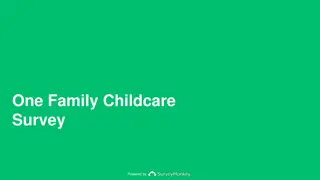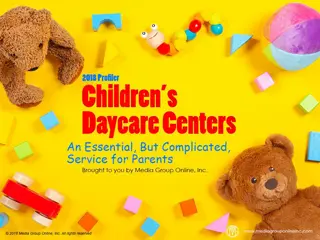Enhancing Childcare Policies for Societal Progress in EU
The Recovery and Resilience Facility (RRF) plays a crucial role in strengthening childcare policies, particularly focusing on the next generation's well-being. Quality childcare programs aid in developing vital skills and fostering full-time employment, especially for women, while reducing inequalities. Despite the importance of childcare, many EU countries face challenges such as low coverage, territorial inequalities, and lack of quality services. Key initiatives like the European Child Guarantee and the European Care Strategy aim to address these issues and break the cycle of disadvantage.
Uploaded on Sep 10, 2024 | 5 Views
Download Presentation

Please find below an Image/Link to download the presentation.
The content on the website is provided AS IS for your information and personal use only. It may not be sold, licensed, or shared on other websites without obtaining consent from the author.If you encounter any issues during the download, it is possible that the publisher has removed the file from their server.
You are allowed to download the files provided on this website for personal or commercial use, subject to the condition that they are used lawfully. All files are the property of their respective owners.
The content on the website is provided AS IS for your information and personal use only. It may not be sold, licensed, or shared on other websites without obtaining consent from the author.
E N D
Presentation Transcript
The role of the RRF in strengthening childcare policies FEPS Recovery Watch 21 September 2022 Francesco Corti, CEPS and Cabinet of Belgian Federal Ministry of Health and Social Affairs Christian Morabito, FEPS, Save the Children and UNICEF
Why a focus on childcare? Participation in quality childcare programmes leads to positive gains, particularly for the most disadvantaged children, in the acquisition of abilities and skills whose benefits can be seen beyond childhood into later educational and life achievements. Availability, intensity, reliability and affordability of childcare plays a key role in promoting full time employment, especially for women, and reduce inequalities by increasing revenues of low-middle income households. Covid-19 has showed how childcare represent an essential service to sustain employment and social inclusion. European Union: Investing in Children: breaking the cycle of disadvantage (2013) Quality Framework for ECCE (2019) The European Child Guarantee (2021) The European Care Strategy (2022) .the RFF as the main source of financing expansion of quality childcare (One of the six RRF Pillars have an explicit focus on childcare policies for the next generation, children and the youth, such as education and skills).
A gloomy scenario across and within countries Children aged less than 3 in formal childcare (2019) Only half of EU member states reached the objective of 33% ECEC coverage (and only few are closed to the new Care Strategy target of 50%). In seven countries, participation in childcare is 20% or less 70 60 50 40 30 20 10 Most children enrolled in service of fewer than 30 hours a week (against new Care Strategy sub-target, and also undermining the work-life balance for parents) 0 CZ SK PL RO HR HU BG AT IT LT LV CY DE EE EL EU FI MT IE SI FR PT SE BE ES LU NL DK Inequalities in access, favoring higher household income (against sub-target of the Care Strategy), due to lack of public places and relevance of private providers. Source: Eurostat
Territorial inequalities and lack of quality Strong territorial inequalities within countries (see left example IT, regions and cities) and, also at micro-territorial level (see example of Bruxelles, affordable places, among communes ). Structural quality (educators' salaries, contracts, qualification) and process quality (curriculum, pedagogical guidelines) often missing, undermining inclusiveness of services, and effects on children s development Source: MIUR (2020) Italy
Status of childcare in selected countries PT highest number of places in childcare facilities, around 50% coverage. ES 40.2%. DE 31.3% coverage (expanded in 1990s, but still very low 0-1 years old). IT 26,9%. SK among the lowest rates of coverage of childcare for children below age 3 (less than 5%). PT lack of publicly financed (accessible) services in Lisbon, Porto and Setubal (60% at national level. In these regions private providers prevalent). ES, IT, DE: important differences across regions in publicly funded provision. PT 60% of services are run by non-profit, funded by government, but the amount of the contribution does not cover the total cost per child. Providers usually privilege enrolment of children from middle- to high- income families. DE level of financing varies among territories, so are contribution to enroll low-income children (poorer areas, less accessible places). In ES, IT, SK, large share of private providers undermine access to lower income children. PT low quality (high intake vs. only 0.5 % for childcare and preschool education, among the lowest levels of spending among OECD countries). ES low salaries and temporary contracts for staff, no national standards on the minimum number of hours. DE and IT quality is higher, but large differences among territories. SK quality standards no existing (e.g. no official qualification requirements for staff).
Does RFF enhance accessible childcare? Additional investment needed (EUR mln) Places needed to reach 33% public Public coverage (%) Number of public places Investment RRF (EUR mln) Increase in places Country Places RRP Places gap Germany 28,70% 680.502 101.957 1.000 90.000 13% 96.906 1.994 Italy 13,50% 183.737 265.398 3.600 225.000 122% 67.371 1.078 Spain 20,90% 244.319 141.227 667 65.382 27% 77.047 613 Portugal 28% 71000 30.118 110 11.000 9% 19.118 185 Slovakia 2,28% 4.074 58.966 0 0 0% 58.966 * Apart from SK, all other countries included investments in childcare in RFF. RFF could be a game changer, by increasing public (or publicly funded) coverage and reducing existing territorial and between households inequalities: IT might increase public coverage by 50%, ES 30%, DE 13 % and PT 9%. IT and ES include an explicit territorial criterion in the allocation of RFF, accounting for the ex-ante unequal distribution of services, and (in case of IT) SES status of children Distribution of funds done via public tenders, with very strict and detailed requirements (e.g. co-funding) undermine chances of providers in most vulnerable areas to apply/obtain funds RRF supports capital investments while recurrent costs should be borne by national governments. If governments do not also provide adequate funding (e.g. regions or municipalities in particular the most disadvantaged) they might be discouraged and do not apply or apply and then give services to provide providers reduce quality .
Key take-aways RRF is indeed an occasion to put the money where the mouth is. Yet this is not the case for all countries There are countries that don t consider at all any investment in childcare despite lagging behind (SK) There are countries that do invest in childcare but without any consideration regarding the territorial dimension (DE and PT) There are countries that do account for territorial disparities (IT and ES). Yet, in the implementation, they encounter problems: Discretion is left to regions to decide how to allocate the funds internally (ES) Since money are channelled via public procurement most disadvantaged territories renounce to apply for funding due to threefold problem: financial (no resources for recurrent costs) regulatory 8complexity of procedures) and timing (no time to apply for multiple funding opportunities) (IT) None of the country accompanies a reform of the childcare systems to the investments This turns particularly problematic in those countries with low structural and procedural ECEC quality (e.g. PT)
How to strengthen childcare in EU? Need more data to analyze the status of childcare at territorial level (not only between countries, but also regions, and within regions following the principle of territorial and social cohesion), inequalities in access based on income, time of services, and structural quality and spending (RFF) Need also qualitative data (curriculum, inclusive education, consultations with local authorities about constrains in planning, spending etc.) A biannual Child Report (Child Guarantee, Care Strategy)/semester (assess, revisit MS milestones and targets, proposals of reforms etc.) Adequate technical support, in particular to small and/or disadvantaged regions, municipalities, using existing best practices Reflection at the EU level on how to treat expenditure in childcare in the revisited fiscal framework to avoid the paradox whereby the EU provides great amount of funds to buildservices but keep fiscal rules that prevent countries to spend money to sustain these services .



